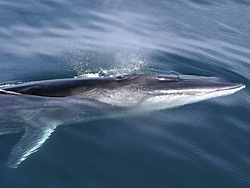A giant whale spotted around Scotland’s west coast is at the centre of a conservation row.
The fin whale is the world’s second largest creature on earth after the blue whale. Growing up to 27 metres long, they can weigh as much as 120 tonnes.
But the International Union for Conservation of Nature (IUCN) has now down-listed fin whales from ‘endangered’ to ‘vulnerable’ in its latest review.
Established in 1964, the IUCN is considered the global authority on the status of the world’s species.
However, leading cetacean charity Whale and Dolphin Conservation says it is concerned about the change.
According to the IUCN, the downgrade was made, in part, because commercial whaling ‘has been brought under control’ but goes on to say that a rigorous evaluation against the criteria they use for listing was not possible, said WDC.
The change was based on ‘plausible projections of the global mature population size’ and encourages further data collection.
Contrary to the IUCN’s view, commercial whaling is not ‘under control’, said WDC.
“A signal of species recovery should by no means be taken as a sign that populations can withstand any level of commercial whaling, given the multiple other man-made threats to whales, along with uncertainties around population structure and ondeed the health of that population,” said WDC anti-whaling campaigner, Vanessa Williams-Grey.
Despite the global ban on commercial whaling, which came into force in 1986, fin whales are still targeted by Icelandic whalers, who have killed 851 since Iceland resumed commercial whaling in 2006.
Last summer alone, 145 fins died, along with two rare blue/fin whale hybrids.
Fin whales have been spotted on several occasions this summer near Tiumpan Head Lighthouse on the Isle of Lewis.
